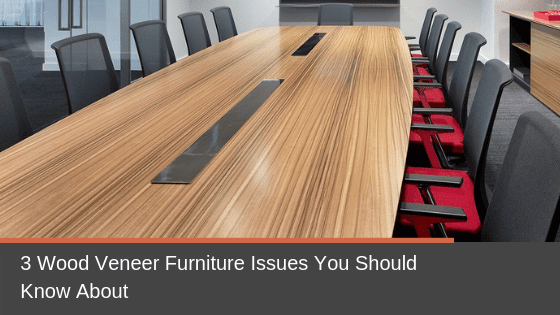Wood veneer and laminate are by far the most popular finishes for office furniture, and for a good reason. Both are functional, durable and stylish. Wood veneer scores exceptionally high marks in the style department and is second only to real wood when trying to make a design statement.
But there are a few downsides to wood veneer. And as we did in this blog post about common issues with laminate, we’ll now focus on a few things to think about before buying wood veneer office furniture.
Wood Veneer Furniture Problems
#1. It’s Costly
This is the biggest reason people decide not to buy wood veneer furniture. While it’s an affordable alternative to solid wood, it’s considerably more expensive than the most popular finish for office furniture: laminate.
It’s costly because the top layer is made from real wood, which is why it looks so impressive.
The big question to ask yourself is, “Is it worth the higher price tag?” If you’ve got your heart set on wood veneer, there are ways to reduce the cost. For one thing, you can use wood veneers on the desks, tables and shelving in high-profile places like boardrooms, reception areas and executive offices, and then go with a less expensive finish for the furniture in general work areas.
#2. It’s Easy to Damage
Because it’s made from natural wood, wood veneer is prone to scratching and gouging, which can quickly make it look weathered and worn. And unlike solid wood, when wood veneer gets damaged it’s not easy to repair by sanding away scratches because the top wood layer is thin and easy to cut through.
Wood veneer is also susceptible to water damage, especially around the edges and seams. That’s because the veneer is glued to the core materials underneath, so moisture can seep underneath it and loosen the top layer and cause it to bubble or peel.
It’s important always to use coasters when you have cups and glasses laid on veneer surfaces. And, because the wood layer is porous and soaks up moisture, it’s important to clean up spills right away to prevent stains.
To offset this, you can choose higher quality wood veneers that are more resilient. Wood veneer is manufactured using thin strips of hardwood that are glued to an engineered wood substrate made from particleboard, medium-density fibreboard (MDF) or plywood.
Cheaper veneers will have a less resilient core material, so if you’re looking for something that’s going to more durable, choose furniture made from MDF, which is considered of higher quality and stronger than particleboard.
#3. It Needs Maintenance
Because the top layer is genuine wood, wood veneer requires maintenance. Not as much as solid wood but certainly more than laminate. It’s wise to prevent damage by regularly using wood oils and protective sealants.
It’s also essential to avoid exposure to extreme changes in temperature and humidity, which can make the wood expand and contract. This can cause the layers to separate or the veneer to crack.
Along with a regular maintenance schedule, you should also have, climate control capabilities in your office space, so the air doesn’t get either too moist or too dry. And if there is a nick or gouge in the surface, it needs to be filled right away to keep it from spreading.
Go for Quality if Buying Wood Veneer
Buying office furniture is always a balancing act between buying what you want and what your budget can handle. In the end, if your priority is the aesthetics and design over price or durability, the choice is a no brainer. Wood veneer is the way to go.
But, as you can see, it does have a few downsides. Most of our customers have shifted to buying primarily laminate furniture, but only you can decide if a wood veneer is the right call for your business.
Wondering how much veneer furniture costs? Or what kind of warranty it has? Read our Ultimate Guide to Purchasing Office Furniture, all the most common questions our customers ask!
Cory Porteous
Director of Marketing & Inbound Business Development
Office Interiors




